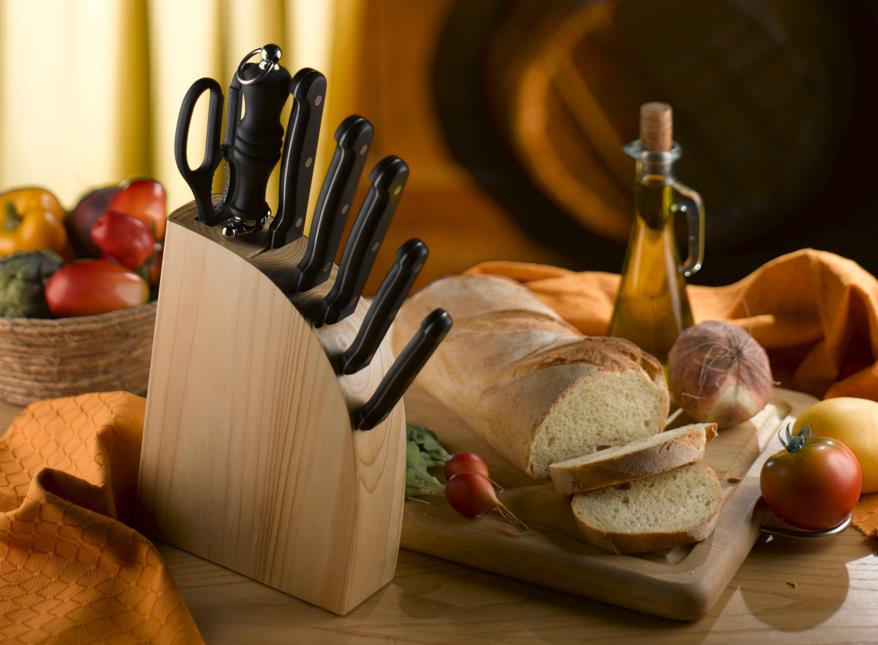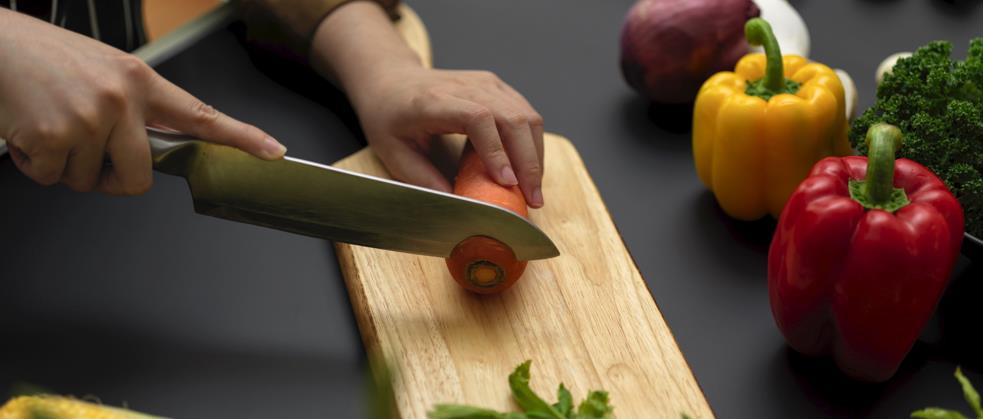Faced with the wide array of knife ranges available today, it can be daunting to identify a knife. This article aims to demystify two of the most popular knives out there – utility knife vs chef knife.
The two knife varieties are popular and consistent bestsellers because they’re kitchen essentials. The chef’s knife and its pal the utility knife are the backbone of many chef’s collection. They’re the knives you’ll turn to most often, and the knives you’ll get the most use out of, that’s what makes them so great.
They’re both kitchen multi-purpose knives, yet they differ in size, cutting styles, and more! Continue reading to learn more about their distinctions.

Table of contents
What is a chef’s knife?
A chef’s knife is a large, multipurpose cutting knife with a wide blade that tapers to a point. What we know today as a chefs’ knife was originally developed for cutting up/jointing large joints and animal carcasses, hence the need for a monster blade!
What is a chef’s knife used for?
Because of its large size and heavier blade, the chef’s knife can cover a multitude of tasks. It’s weight and heft make taking a roast off the bone a cinch, and its finer tip and sharpness also means you can use it for finer jobs like chopping herbs and trimming vegetables to your preferred style.
Need to chop up a large and thick – skinned squash that another knife would struggle with? This is the tougher kind of task that your chef’s knife was made for! Have to debone and trim a quarter of lamb? Your chef’s knife will be your best friend here.
Pros and cons of the chef’s knife

Pros
- High level of control means there’s less slippage or accidents!
- Multi – purpose versatility
- A good quality chef’s knife is VERY sharp, making for quick work
- Cuts your ingredients without crushing fibers or cells
- A good quality chef’s knife blade is durable
- Weight – good quality chef’s knives have a satisfying weight and balance in the hand, making chopping and slicing a doddle
- Chef’s knives are easily sharpened
Cons
- Initial purchase cost relatively expensive for good quality
- Large size can mean it’s not easily transported and a bit ‘clunky’
- Very sharp means very dangerous if used improperly!
What is a utility knife?
A utility knife is medium sized, slim and of low weight, with a narrow blade that tapers to a point at the end. This knife combines paring and slicing knives, it fits neatly in the middle with the capabilities of both.
What is a utility knife used for?
The hint is all in the name here – utility means useful, especially through being able to perform several functions, and that’s this knife in a nutshell. A utility knife is, like the chef’s knife, a kitchen all-rounder but on a slighter and smaller scale. So, what jobs would we use our utility knife for?
Utility knives are kitchen workhorses, and you’ll get so much use out of them – cutting up smaller vegetables, slicing meats and chopping up herbs. Utility knives that have serrated blades are especially handy for slicing up bagels, pastries and sandwiches. Although not big enough to tackle a full loaf of bread, the utility knife is your smaller baked goods champion.
And, utility knives because of their lighter blades are pros at segmenting fruits like your citrus – grapefruit, oranges, and the like. They also deal admirably with thin-skinned vegetables like varieties of onion and cucumber.
Pros and cons of the utility knife?
Pros
- Smaller blade means more precision for ‘finicky’ jobs like segmenting fruit
- A serrated blade makes short work of baked goods like bread
- Due to its smaller size it’s more portable than a chef’s knife
- Utility knives have thinner blades so can achieve a high level of sharpness
- Usability – A utility knife fits neatly between chef’s and paring knife size ranges, it’s neither cumbersome or unwieldy to use or move around
- Lower purchase cost as opposed to upper end chef’s knives
Cons
- Not designed for heavy tasks like jointing a carcass
- Thinner blade means less durability than a chef’s knife
- Low quality utility knives will need replacing regularly
- Lighter construction can lead to slippages and cuts if not used carefully
- If it has a serrated blade, it will take a bit longer to sharpen
Handpicked for you
True cutting power in the palm of your hand
How are a chef’s knife and a utility knife similar?

If you put a large utility knife and a small chef’s knife alongside each other, you’ll see immediately that there is overlap between the size parameters, they’ll be of equal size.
Both types of knife blades are made from the same materials too, materials common to knife manufacture like stainless steel, carbon steel, ceramic and so on.
The handle material will also be the same – stainless steel, carbon fiber, wood, aluminum and titanium are all popular choices for knife handles.
Both types of knives will be found in the vast majority of kitchens, simply because they’re kitchen mainstays and so gosh darn useful that no self–respecting food prepper would be without them!
How do a chef’s knife and a utility knife differ?
Let’s start by looking at how they’re designed.
Knife Design
A chef’s knife is designed as a large (8 to 12 inches) multi-purpose kitchen knife, commonly with one of two blade shapes. The German blade is deeply and consistently curved along the cutting edge, whereas another blade design will be straighter along the cutting edge until it gets to the end, and then it curves up to the tip.
Chef’s knife usually has a smooth ‘V’ edge without serrations or scalloping. And the blade will be thicker than a utility knife for heavier usage.
Utility knives, on the other hand, are designed to fill the gap between your slicing and your paring knives. It’s a medium-sized knife. The blade will be longer than a paring knife, usually between 4 to 7 inches, and may feature either scalloped or serrated edges. There is no curve along the blade itself.
Unlike the chef’s knife, a utility knife is straight-bladed, and its V edge can be either smooth or serrated. This blade is thinner in construction than a chef’s knife blade, which means precision is enhanced, but that the blade may be more prone to bending or warping.
Uses in kitchen
A chef’s knife is meant for bigger jobs that your smaller and more delicate utility knife can’t handle. So, the handle and the blade will be made of heavy materials that add weight to the action when you use the knife, making your exertion of effort less.
As a multi – purpose tool, chef’s knife can be used in many different sorts of tasks but is usually the knife chosen for raw meat and vegetable prep – those gritty duties like jointing a carcass, skinning freshly caught game or prepping large quantities of hard-skinned vegetables for canning or pickling.
Utility knife, is a lighter, more delicate counterpart to the chef’s knife that can cover a multitude of food prep tasks that a chef’s knife would be too big for. Tasks that require a more finessed touch.
For this reason, chefs and home cooks will use utility knife regularly for slicing and dicing vegetables – particularly into finer shapes like julienne. Or for carving and shaping things like garnishes that require fine work and a steady hand.
Being smaller in size, you can get the edge of the blade between things like orange pith and flesh, making segmenting and excision of soft fruits and juicy, easily damaged vegetable flesh possible.
If the blade of your utility knife is serrated, you’ll find one of the things you use it most for is baked goods.
Maneuverability

A chef’s knife by its design and very nature is big, bulky and unwieldy. It’s greatest gift is its generous weight and size, these are the qualities that help you with serious chopping and hacking!
This can also make the chef’s knife a bit of a hassle to use in a very crowded work area or on a tiny surface. Any professional chef will have a dedicated travelling case or sheath for their chef’s knife so that they can pack and transport it easily, because they want to avoid accidents and damage to the knife blade.
The chef’s knife isn’t as maneuverable as its counterpart the utility knife, it’s simply too big to be a pick-up-and-go type of tool.
Compared to the bigger and bulkier chef’s knife, a utility knife is more convenient to carry around. Although a dedicated carrying case is never a bad idea for your treasured knife collection!
Utility knives are on the smaller side and lighter in construction, with thinner blades than chef’s knives, making them easier to use in small spaces and more efficient in terms of packing and transporting. You could arrange a variety of utility knives on your work surface, and they would take up about the same room as one really large chef’s knife.
Durability
Yes. Good quality chef’s knives are built to last with tough materials, heavy component metals and a high level of craftsmanship. Due to a thick blade design, the chef’s knife can withstand rough use that would damage a utility knife’s blade.
Utility knives are not as tough/sturdy as chef’s knives – they’re not as solid and weighty. That being said – it all comes down to the quality of the knife that you buy!
A good quality utility knife should last you many years, given the proper care and maintenance. You won’t (and should never) attack hard materials like large bones with it, but it’ll serve you well over time if you use it for the purposes it was designed for.
Chef’s or utility – which one is for me?
Simply put, every kitchen and home cook needs both. As they fulfill different functions, you’ll use both regularly and never regret the money spent on them.
Your chef’s knife covers your HEAVY work, and your utility knife is your bestie for the LIGHTER tasks. Together, you’re a kitchen superstar baby!
If you intend to purchase a quality chef knife, don’t hesitate to stop by our store for handmade high carbon knives.












